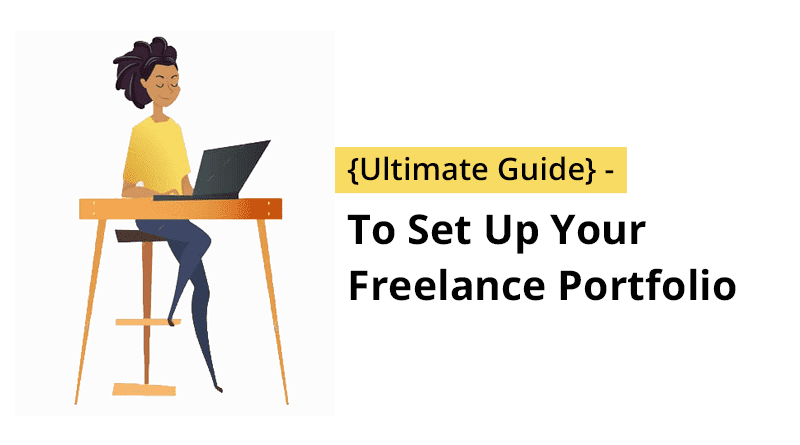Freelancing makes you the boss of your own work. Thus, many youths are switching to freelancing and looking for it as a carrier. Freelancing gives you the independence of doing your work at your time, but at the same time, you are supposed to make your audience believe in you. The first thing to do before starting your freelancing journey, is creating your portfolio. It is the most crucial marketing tool you have as a freelancer. Your portfolio represents the things that you are good at.
What Is Freelancing?
Freelancing means doing the contracted work for multiple clients and companies as per your knowledge. So, if you are a content writer, web developer or a web designer and want to work as a freelancer then you have the choice to work for different clients on different specialties. The freelance particularly denotes the term as self-employed, for an individual who not necessarily commits to a particular organization for the long term.
Now, you have understood that you need the proof that indicates you are good at selling the product or service you work for. And to support your work and experience every freelancer needs the portfolio.
What Are The Parameters Of A Portfolio?
Even if you are a highly skilled freelancer, no-one will notice your work as long as you don’t take the efforts to position yourself in this competitive market. Formatting a portfolio can become a burden for some people as you need to talk about yourself, your skills, experience, achievements, strengths, and weaknesses that don’t always come naturally. So, here are 6 parameters that guide you to create your freelance portfolio.
# 1: Tell about your specialty :
Your portfolio should highlight, what work you can do in a better way. Your specialty indicates what you are known for and gives you the title you would like to be called. Be specific while highlighting the title for your specialty. For e.g: Titling ‘digital marketer’ or ‘graphic designer’ is vague. But, titling ‘Social media marketer’ or ‘logo designer’ helps you to stand unique in your client’s view.
# 2: Support your specialty with your work :
When you declare yourself as a specialist in a particular category, then it must provide proof for the same. Actually, this is a good opportunity to represent and highlight your work in front of your client. You can show some low-key projects on your portfolio but make sure that you emphasize on your best work, that means a big brand client or the project where you have got the recognition. How about displaying your recognition certificate?
This surely acts as solid proof for your work and helps you to get more leads from your client.
 #3: A simple photograph :
#3: A simple photograph :
You might have noticed on many job searching sites or portals, you have been asked to upload your photograph so as to increase the potential weightage of your portfolio, the same applies here also. People like to know more about you, and your picture tells them a lot about you.
Tip: Always choose a simple and decent picture for your portfolio. Avoid using a photograph from the parties or vacation trips.
# 4: Easy to see contact information :
Make sure that no medium is left, for the client to reach you.
This information may include –
• Name
• Permanent Address
• Phone number / Mobile Number
• Email Address
• LinkedIn URL
Don’t hide this information at a place that cannot be seen easily.
 # 5: Educational and Related details :
# 5: Educational and Related details :
Showing your education details increases the chance of getting you hired. You can also, tell your strengths that are related to the work you do. Like, if you are a ‘logo designer’ then, you can add ‘a creative person’ as your strength.
# 6: Add a good call to action :
You can add a strong call to action by showing some of your best testimonials and relating it to your bio information.
Follow these steps to create an informative and eye catchy portfolio.
Once you are done with the portfolio, you will have to determine where to host your freelance portfolio. It is always an easy way to invest in a good hosting company that allows you to create your own website or directly host your portfolio website.
It is easy to create your own website using the website builder tool, where you just have to drag and drop the contents in the themes provided. This will not consume more of your time and also, will give a professional look to your portfolio.
Host A Portfolio Website :
(1) Decide a professional domain name –
Spend some time to think about the domain name that suits your work. Don’t rush for the free domain names like .wordpress or .tumblr as they look more unprofessional. Instead, choose a .com or .org or .in domain or whatever extension you like to end up your site URL pattern.
Related: Google Announces New TLD for Developers
(2) Choose the hosting plan –
You can choose the hosting plan as per your need. That means if you don’t want to spend much on this then shared hosting plans can solve your problem.
Related: VPS or Shared Hosting: Which Is The Best For Your Business?
How to stand odd against all evens?
For freelancing, it becomes very important to mark yourself the best among others, so as to catch more eyeballs to your portfolio work.
Here Are Tips To Do So:
(1) Choose the right platform :
Choosing the “right” platform depends on the factors such as your goals, skills, budget and skill level, as, these help to decide it.
You can opt for platforms like LinkedIn, Behance, Dribble, etc depending on your industry niche.
(2) Take opinions :
Take help from family members, friends or some professionals to go through your portfolio. Ask them to have a look at the overall flow, and identify the wrong spellings, the grammar used. You can ask them to rate your portfolio on the basis of ease of reading because you cannot afford to confuse your clients by showing them an improper portfolio.
(3) Add Updates regularly :
The same portfolio doesn’t work for a longer time period. It should be updated at regular intervals of time. The dead sites lose the interest from your clients and maybe they showcase that you have lost interest from your freelancing job.
So, make sure that you update your portfolio with the latest work, latest achievements, and certificates to gain more viewers to your page on a regular basis.
Summing Up :
Your freelance portfolio acts like your CV that makes the first impression about you in front of your clients. This is the best opportunity for you to highlight your work and showcase your talent to the world. So, make sure that you have a strong portfolio for your freelancing work.







